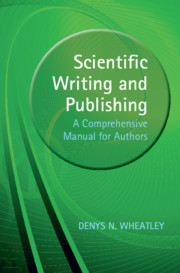Book contents
- Scientific Writing and Publishing
- Scientific Writing and Publishing
- Copyright page
- Contents
- Acknowledgements
- Introduction
- 1 General Features of a Scientific Paper
- 2 The Typical Scientific Paper
- 3 Results
- 4 Discussion
- 5 The Introduction
- 6 Materials and Methods
- 7 The Abstract
- 8 The ‘Smaller’ Sections That Complete a Paper
- 9 Figures and Tables
- 10 Presubmission
- 11 Submission of Manuscripts
- 12 Peer Review
- 13 The Last Stages of the Editorial Process
- 14 From Acceptance to Publication
- 15 Copyright
- 16 Ethics and Scientific Integrity
- 17 Epilogue
- Further Reading
- Index
6 - Materials and Methods
Published online by Cambridge University Press: 14 October 2021
- Scientific Writing and Publishing
- Scientific Writing and Publishing
- Copyright page
- Contents
- Acknowledgements
- Introduction
- 1 General Features of a Scientific Paper
- 2 The Typical Scientific Paper
- 3 Results
- 4 Discussion
- 5 The Introduction
- 6 Materials and Methods
- 7 The Abstract
- 8 The ‘Smaller’ Sections That Complete a Paper
- 9 Figures and Tables
- 10 Presubmission
- 11 Submission of Manuscripts
- 12 Peer Review
- 13 The Last Stages of the Editorial Process
- 14 From Acceptance to Publication
- 15 Copyright
- 16 Ethics and Scientific Integrity
- 17 Epilogue
- Further Reading
- Index
Summary
This is a part of the scientific paper that today is often appended after rest of the paper has been reached. It has to give details of the techniques used, the reason for their selection and exact details of the procedures.The need for proper controls is discussed. Sources of materials have to be identified, modifications and limitations are to be included. Confidence in the data that emerges means that statistical tests must be appropriate. How this quite tedious section of the paper can best be assembled is explained.
- Type
- Chapter
- Information
- Scientific Writing and PublishingA Comprehensive Manual for Authors, pp. 83 - 92Publisher: Cambridge University PressPrint publication year: 2021

